Plant Profiles
Click on the first letter of the common name of the plant you wish more information about.
A | B | C | D | E | F | G | H | I | J | K | L | M | N | O | P | Q | R | S | T | U | V | W | X | Y | Z
W
- Walking Iris
- Wax Myrtle
- Wheat Celosia
- Whirling Butterflies
- White Bird of Paradise
- White Rain Lily
- White Trailing Lantana
- Wisteria, Chinese
Walking Iris
Scientific Name: Neomarica longifolia
Growth Habit: Upright evergreen perennials with yellow-green foliage growing to 2 feet tall; a member of the iris family with lancelike leaves that arise from rhizomes growing just below the soil surface.
Light: Plant in filtered sun.
Feedings: Apply general garden fertilizer once each month in March, June and September.
Water Needs: Prefers a moist soil; water at least once a week during hot, dry weather.
Ease of Culture: Easy.
Propagation: Start new plants by dividing older clusters. Also remove new plants from the ends of flowering stems that bend down to the ground to grow roots and shoots (thus the name walking iris).
Hardiness: Medium; plants are severely damaged by freezing weather but usually grow back from rhizomes near the ground.
Major Problems: Plantings occasionally are damaged by caterpillars and other leaf-feeding insects, but controls are seldom needed.
Pruning: Remove declining foliage as noted. Also trim cold-damaged leaves in early March as plantings begin growth. Remove arching flowering stems before they root in the soil to keep plantings in bounds.
Uses: Walking irises are ideal plants for shady garden sites. Cluster several plants in a flower bed for a burst of color, use them as a ground cover, or to line walkways. The plants grow well in the damp sites and bog gardens. Plantings open 2-inch-diameter yellow blooms with brown markings April through October.
Florida Native: No; native to Brazil.
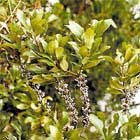
Wax Myrtle
Scientific Name: Myrica cerifera
Growth Habit: A multitrunked semi-evergreen forming a rounded large shrub to small tree; grows to 20 feet tall. Leaves are narrow and grow to 3 inches long.
Light: Plant in full-sun locations.
Feedings: Feed new plants during March and June with a general garden fertilizer for the first three years. Established plants get nutrients from nearby lawn and shrub feedings or decomposing mulches.
Water Needs: Drought tolerant. Keep new plantings moist until roots grow into the surrounding soil. Established plants usually get adequate water from seasonal rains.
Ease of Culture: Easy.
Propagation: Start from seeds or by removing shoots sprouting from the roots.
Hardiness: Hardy.
Major Problems: Wax myrtles have several diseases that cause die-back and cankers forming within the trunks. Prevent decline by avoiding plants dug from the wild and using clean pruners when trimming.
Pruning: Decide whether you want a tree or a shrub, and thin to the desired number of trunks. Shrubs are trained with numerous trunks and trees to three or five main trunks. Prune periodically to remove unwanted shoots from the base and root systems.
Uses: Plant as accent features near entrances, patios and gardens. The flowers are small and a greenish color. Only female plants bear gray berries November through March. Plants can be used as a hedge or a view barrier.
Florida Native: Yes.
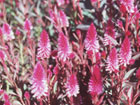
Wheat Celosia
Scientific Name: Celosia spicata
Growth Habit: An upright long-lived annual growing to 30 inches tall and 12 inches wide. The leaves are narrow and grow to 4 inches long.
Light: Plant in sunny locations.
Feedings: Apply a general garden fertilizer monthly.
Water Needs: Drought tolerant for short periods of time but prefers a moist soil; grows best when watered at least weekly during dry weather.
Ease of Culture: Easy.
Propagation: Start plants from seed during the winter months.
Hardiness: Tender.
Major Problems: Leaves are sometimes attacked by caterpillars. Handpick or control with a natural spray. Plant in a well-drained soil to avoid root-rot problems.
Pruning: Trim faded flower heads to encourage growth and additional blooms. Stems of opening flowers also can be cut and tied in bunches to hang upside-down in a shady, airy spot to save and use in dried arrangements.
Uses: An attractive new plume-type celosia with upright tassels of flowers resembling stalks of fruiting wheat. Use in annual flower beds, cutting gardens or planters to enjoy the pink to purplish blossoms held well above the lancelike foliage April through November. Pictured is variety Flamingo Feather, also in bloom during the winter months when grown in containers and protected from the cold.
Florida Native: No: native to tropical Africa.
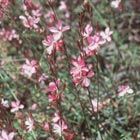
Whirling Butterflies
Scientific Name: Gaura Lindheimeri
Growth Habit: A clump-forming perennial, producing plants growing to a foot tall and flower stalks 3 feet tall. The leaves are medium to dark green, lancelike and toothed, growing to 4 inches long and a half-inch wide.
Light: Plant in a full-sun location.
Feedings: Apply a general garden fertilizer once monthly in March, June and September.
Water Needs: Drought tolerant; grows best with waterings every seven to 10 days.
Ease of Culture: Easy.
Propagation: Start plants from seed or cuttings.
Hardiness: Hardy.
Major Problems: Chewing insects occasionally may feed on the foliage, but controls are seldom needed. Plant in a well-drained soil to avoid root-rot problems.
Pruning: Remove old flower stalks when all the blossoms fade. Also, groom plants during late winter to remove declining leaves and flower stalks.
Uses: Plants have an unusual flowering habit. They produce small white to pink blossoms at the ends of long stems that resemble butterflies in flight. Cluster several plants for the best color display as an accent feature along walkways and in perennial gardens. Plants also may be mixed with other annuals and perennials in container gardens for balcony or patio displays.
Florida Native: No; but native to Louisiana, Texas and Mexico.
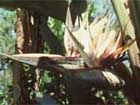
White Bird of Paradise
Scientific Name: Strelitzia nicolai
Growth Habit: An upright treelike evergreen plant growing to 20 feet tall and 10 feet wide. The dark green leaves are oblong and grow 5 feet long and 2 feet wide.
Light: Plant in full-sun to lightly shaded locations.
Feedings: Apply a general garden fertilizer once each in March, June and September.
Water Needs: Drought tolerant and capable of going weeks without water; grows best with weekly waterings.
Ease of Culture: Easy.
Propagation: New plants are best started from offshoots of older clumps. Seeds also can be used but are slow to sprout.
Hardiness: Medium; damaged by freezing temperatures but usually grows back from protected buds near the ground.
Major Problems: White scale and mealybugs are often noted covering portions of leaves, causing them to develop yellow spots and gradually decline. Control with an oil spray as needed. Leaf spot fungal organisms may also be noted but seldom need control.
Pruning: Remove declining leaves and flower heads. Plants also develop large clumps and some pruning of trunks or division of older clusters may be needed to keep plants in bounds.
Uses: Add the tropical look and a terrific accent plant to the patio, pool area and Florida garden with a cluster of the white bird of paradise. This is a tall- and wide-growing plant that needs adequate room, especially above, for the long leaves to develop. Mature plants flower throughout the year, sprouting an inflorescence containing numerous white and blue blooms that are sure to attract attention. Plants also can be grown in large containers.
Florida Native: No; native to Africa.
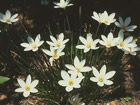
White Rain Lily
Scientific Name: Zephyranthes candida
Growth Habit: An evergreen perennial cluster-forming, bulb-type plant growing to 12 inches tall and 4 inches wide. The leaves are dark-green and grasslike with flattened stems growing to 12 inches in length and 1/4-inch wide.
Light: Grows best in full sun but tolerates light shade.
Feedings: Feed lightly with a general garden fertilizer once monthly in June and August.
Water Needs: Survives with seasonal rainfall; grows best and blooms during the rainy summer and early fall months.
Ease of Culture: Easy.
Propagation: Start plants from seed and by dividing older clusters.
Hardiness: Hardy.
Major Problems: Chewing insects and slugs occasionally might feed on the foliage but seldom need control.
Pruning: Remove flower stems after the blossoms fade or when seeds are gathered for sowing.
Uses: An attractive addition to the perennial garden or as a ground cover throughout the landscape. Perhaps the best use is in clusters spotted throughout the garden or along walkways, as the plants send up white lilylike blooms when many other flowering plants begin to decline August through October. Plants also can be grown in containers and displayed when in bloom.
Florida Native: No; native to the La Plata region of South America.
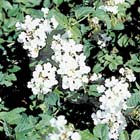
White Trailing Lantana
Scientific Name: Lantana montevidensis 'Alba'
Growth Habit: A sprawling evergreen ground cover with vinelike stems growing to 2 feet tall and 4 feet wide. The leaves are thick, oval, toothed along the edges and produce a pungent fragrance when crushed; they grow to more than an inch long and half as wide.
Light: Grows and flowers best in full sun but tolerates light shade.
Feedings: Apply a general garden fertilizer once in March if adequate moisture is available for growth and once during the summer.
Water Needs: Drought tolerant; grows best if watered every other week during hot, dry weather.
Ease of Culture: Easy.
Propagation: Start plants from cuttings.
Hardiness: Medium; damaged by frosts and freezes but usually grows back from stems near the ground.
Major Problems: Leaf miner, whiteflies, caterpillars and garden flea hoppers blemish leaves but seldom need control. Leaf spotting may occur if plants are grown in shade and during the summer rainy season.
Pruning: Control growth with periodic trimming to prevent plants from overgrowing the allotted space. During mid-February, trim plants to near ground level to remove cold damage and renew growth.
Uses: A rapidly growing ground cover that can be used in the dry, well-drained problem areas of the landscape, plus in foundation and perennial garden plantings. May be added to containers, planters and hanging baskets. An attractive plant to overhang walls and balconies. Flowers are produced above the foliage in clusters along the stems year-round except when affected by cold. Variety Alba is a white selection, but gardeners also may select the lavender-flowered species to plant.
Florida Native: No; native to South America.
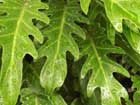
Xanadu Philodendron
Scientific Name: Philodendron x 'Xanadu'
Growth Habit: A rounded shrub, with evergreen deeply cut leaves, growing to 3 feet tall.
Light: Tolerates full sun; grows best in filtered-sun to shady locations.
Feedings: Apply a balanced fertilizer once monthly in March, May and September.
Water Needs: Survives short periods of drought; grows best with weekly waterings.
Ease of Culture: Easy.
Propagation: Commercially started through tissue culture; can be rooted from cuttings.
Hardiness: Tender; plants in shade normally survive cold with a cover.
Major Problems: Plantings are mostly pest-free. Grow in well-drained soils and avoid keeping wet to avoid root-rot problems.
Pruning: Plantings grow slowly but steadily and may need pruning to avoid competition with nearby ornamentals. Pruning is normally needed after severe cold to remove declining foliage.
Uses: An excellent plant for shady gardens, foundation plantings and borders. Also can be grown in containers to use indoors or on the patio.
Florida Native: No; a hybrid.

Yarrow
Scientific Name: Achillea millefolium
Growth Habit: A clump-forming evergreen perennial forming a base of arching foliage with flowering shoots growing to 2 feet tall. The leaves are gray-green, fernlike and deeply divided, growing to 6 inches long and 1 inch wide.
Light: Plant in full sun to lightly shaded locations.
Feedings: Apply a general garden fertilizer once monthly in March and June.
Water Needs: Drought tolerant, surviving for weeks without water; grows and flowers best with weekly waterings.
Ease of Culture: Easy.
Propagation: Start plants from seed or by division of older clumps.
Hardiness: Hardy.
Major Problems: Plant in well-drained soils to avoid root-rot problems. Foliage may be affected by chewing insects, but controls seldom are needed.
Pruning: Trim declining flower heads to encourage a continuous bloom. Remove flowering shoots when the stems begin to brown. Edge beds and planting sites as needed to prevent yarrow shoots from invading nearby plantings.
Uses: An attractive flower, blooming March through May for the perennial flower bed and rock garden. Flowers open white, pink and red in clusters at the tops of tall shoots. The stalks of blossoms can be cut for bouquets or saved for dry flower arrangements. Plants also may be grown in containers for porch, balcony or patio displays.
Florida Native: No; native to Europe and western Asia.
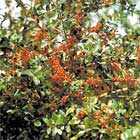
Yaupon Holly
Scientific Name: Ilex vomitoria
Growth Habit: An evergreen upright to rounded small tree or large shrub growing to 20 feet tall. The plants are twiggy and have small spine-free leaves.
Light: Plant in full-sun to lightly shaded locations.
Feedings: Feed lightly in March and June for the first three years. Thereafter adequate nutrients are obtained from decomposing mulches plus nearby lawn and shrub feedings.
Water Needs: Drought tolerant; can usually exist with the moisture from seasonal rains.
Ease of Culture: Easy.
Propagation: Start plants from seeds or cuttings.
Hardiness: Hardy.
Major Problems: Light leaf loss may be noted because of fungal leaf spots and leaf minor insect damage. Controls seldom are needed.
Pruning: Yaupon hollies produce shoots from the base and the roots that compete with the central trunk. Prune the shoots to the ground as needed to keep an attractive tree.
Uses: Often planted as small accent trees near patios and walkways or can be added as a backdrop for flower gardens and shrub plantings. Female selections produce shiny red berries during fall and winter. The fruits are a favorite food for wildlife. A weeping form known as Pendula is available.
Florida Native: Yes.
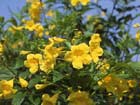
Yellow Elder
Scientific Name: Tecoma stans
Growth Habit: An evergreen, rounded, large shrub to small tree with numerous branches growing to 15 feet tall and wide. The bright-green compound leaves grow to 10 inches long and half as wide with up to 13 leaflets.
Light: Plant in full-sun locations.
Feedings: Apply a general garden fertilizer once monthly in March and June if needed to encourage growth.
Water Needs: Drought tolerant; can exist with seasonal rains.
Ease of Culture: Easy.
Propagation: Start plants from seeds or cuttings.
Hardiness: Tender; damaged by severe freezes but can grow back from buds near the ground.
Major Problems: Chewing and scale insects occasionally might feed on the foliage and stems but seldom need control.
Pruning: The trees have a free branching habit and need trimming to keep a central trunk. Remove limbs of young trees competing with the central leader. Plants with multiple trunks can be grown to produce large shrubs. Remove out-of-bounds limbs as needed to keep the rounded growth habit. Also, remove any cold-damaged limbs during February just before growth.
Uses: An attractive accent plant that opens clusters of bell-shaped yellow blossoms March through December. Plant near the patio, near entrances and along walkways for a burst of color. Plants also can be grown in containers to set on patios or decks.
Florida Native: No; native to the Caribbean region.
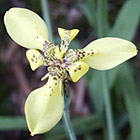
Yellow Walking Iris
Scientific Name: Trimezia martinicensis
Growth Habit: An upright evergreen, perennial, bulblike plant with foliage originating from near the soil line. This is an iris relative with swordlike foliage that grows to 30 inches tall and 11/2 inches wide.
Light: Grows in full sun to shade.
Feedings: Apply a general garden fertilizer once monthly in March, June and September.
Water Needs: Drought tolerant; can exist with seasonal rains, but grows best with weekly waterings.
Ease of Culture: Easy.
Propagation: Start plants by division of clumps and removal of "plantlets" that root from the ends of flowering stems.
Hardiness: Medium; damaged by freezes but usually grows back from buds near the ground.
Major Problems: Chewing insects occasionally may feed on the foliage but seldom need control.
Pruning: Remove cold-damaged leaves at the end of February before growth starts. Plants are vigorous and often need trimming to remove excessive plants and keep the foliage in bounds.
Uses: Plant in clusters to enjoy the attractive yellow irislike blossoms with brown barred markings April through November. Blossoms last only a day, but the long arching, flowering stems have many buds and leaves that eventually root as the shoots bend down and touch the ground. Add to perennial gardens, shady sites and along walkways. Plants also may be grown in containers for porch and patio displays.
Florida Native: No; native to tropical America, including Brazil, Mexico and Jamaica.
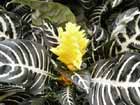
Zebra Plant
Scientific Name: Aphelandra squarrosa
Growth Habit: An upright evergreen perennial growing to 18 inches tall and 12 inches wide. The leaves are dark green with white banding along the veins; they grow to 8 inches long and half as wide.
Light: Grow in a bright location but out of direct sun.
Feedings: Apply a 20-20-20 or similar fertilizer every other week March through November, none during the winter months.
Water Needs: Keep moist by watering when the surface soil begins to dry March through December; allow the surface soil to dry between waterings during the winter.
Ease of Culture: Easy.
Propagation: Start plants from cuttings during warmer spring through early summer months.
Hardiness: Tender; protect from temperatures below 40 degrees.
Major Problems: Aphids, mealybugs and scale insects are common pests. Control as needed with a soap or oil spray, following label instructions.
Pruning: Remove browning inflorescences throughout the growing season. Also use this time to trim lanky shoots and reshape the plants to encourage branching.
Uses: Display in the home or on the patio in containers to enjoy the exotic and tropical look of zebra plants. The variegated foliage creates year-round interest, and bright yellow inflorescences form at the tops of shoots April through December. The small flowers are open for only a few days, but the colorful yellow bracts remain attractive for weeks. Plants can be added to in-ground tropical gardens, but they are usually damaged by the cold weather.
Florida Native: No; native to Brazil.
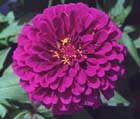
Zinnia
Scientific Name: Zinnia elegans
Growth Habit: An upright to rounded annual plant with broad, fuzzy, light green leaves produced on plants growing to 4 feet tall and wide.
Light: Plant in full-sun locations.
Feedings: Apply a general garden fertilizer once every 3 to 4 weeks to in-ground plantings, weekly to plants in containers.
Water Needs: Prefers a moist soil. In-ground plantings grow best with weekly waterings; check container plantings for daily needs.
Ease of Culture: Easy.
Propagation: Start new plants with seed 6 to 8 weeks before they are needed in the garden.
Hardiness: Tender.
Major Problems: Zinnias are affected by fungal leaf spots and powdery mildew. Newer varieties appear to have some resistance to these diseases, making plantings possible even during the warmer, damp summer. Also check for chewing insects and handpick from the plants as needed.
Pruning: Remove the declining blooms to produce new flowers. Also cut bouquets to encourage flowers and reshape the plants as needed. Trim declining plants from the garden as they complete their life cycles.
Uses: Zinnias are planted March through October. Varieties are available in a rainbow of colors, and blossoms are up to 6 inches in diameter. The blooms have a mild fragrance and attract butterflies. Plant clusters in annual flower beds, along walkways and in container gardens. Use lower growing varieties as borders and taller types as backdrops for other flowers.
Florida Native: No; native to Mexico.

